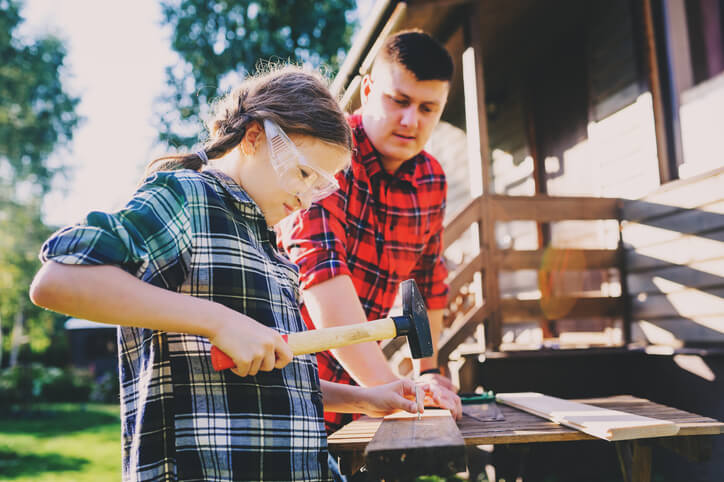While Maryland residents are required to shelter-in-place during the COVID-19 pandemic, there’s plenty of time to keep the kids busy with a few DIY projects. Not only are these projects fun and entertaining, but they can also provide an effective way to teach kids about tools.
When introducing tools to children, take it step-by-step. Explain what each tool is used for, how to use them correctly, and how to prevent accidents. Most importantly, consider which tools are age-appropriate before introducing them to your young ones. An electric saw or drill, for example, should be out of the question until they develop the necessary skills and dexterity.
4 Tips for Safe Tool Use

Get them in the habit of dressing for safety while using tools – such as wearing eye protection and a tucked in long-sleeved shirt.
Take advantage of the newfound free time you have with your family! Utilize the weekend to teach the kids about tools and how to use them safely. But, before you start on a DIY project, begin by establishing some clear ground rules. If kids develop a routine of following safety procedures now, they will likely continue them as adults.
1. Start at the Top
The best place to begin when teaching your kids about tools is to remind them to ask for permission first. Asking for permission should prevent them from using inappropriate or dangerous tools without your supervision. Thus, lessening and preventing accidents and injuries.
On the other hand, keep in mind that you are giving instructions that involve both reasoning and motor skills. So, try to keep them as simple as possible.
2. Dress Safely and Appropriately
Teach your child to get into the habit of dressing for safety while using tools. These include wearing eye protection, long-sleeved shirts – buttoned up and tucked in – closed-toe shoes or boots, and work gloves.
3. Choose Age-Appropriate Tools
There are tools kids can master while still very young. For instance, a hammer or a screwdriver can be a good starting point. From there, you can proceed to more complicated tools, like a power drill or saw.
4. Use and Store Tools Properly
For example, let your kids know that blades should be carried pointing downward and tools should be put away when not in use. Also, remind them not to run with tools and to keep their work area clean to avoid distractions.
Additional Considerations When Teaching Kids About Tools
You are setting your kids up for success when you teach them how to use tools. They are learning to think for themselves while practicing and perfecting their motor skills.
Moreover, there are some additional aspects to consider as you guide them through their projects:
- Supervise from the beginning: Don’t just tell them how to do something, but show them as well.
- Teach them to avoid distractions: Minimize distractions while working – no smartphones! The more they focus on a task, the less possibility of accidents.
- Keep them from accessing unsafe tools: Tools that you don’t want the kids to reach should be locked away and unplugged.
When you teach kids about tools, it’s important to provide a good example for them to follow. Overall, when they see you approach tool use in a particular way, they are likely to emulate your behavior.
Start Your Family DIY Projects at Friel
Creating DIY projects as a family is a great way to release pent-up energy and creativity during the stay-at-home order. Whether your kids are building a camping tent or cardboard castle, learning to use tools is a skill they can bring into adulthood.
At Friel Lumber Company, we have all of the tools you need to construct your DIY projects or home projects, big and small. Questions? Contact us today to get the ball rolling.
